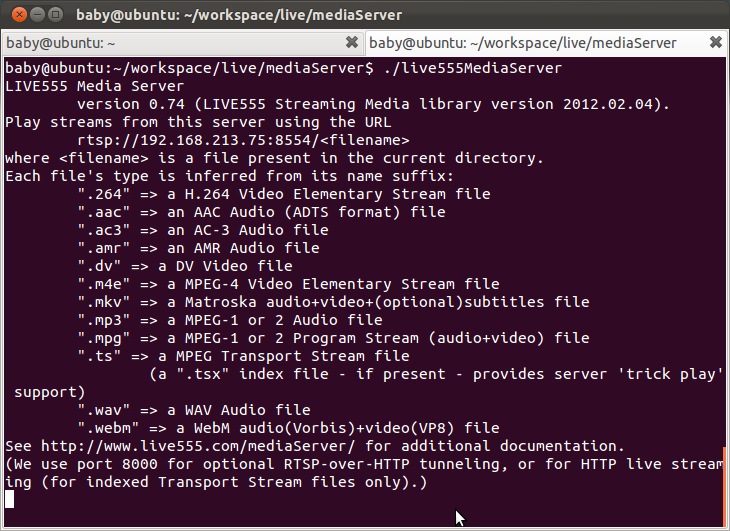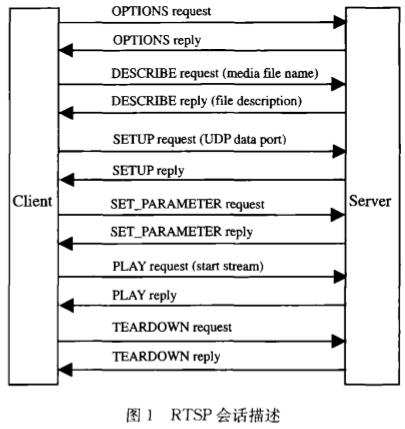基于移动平台的多媒体框架——使用live555接收流媒体方法简介
更多关于live555的详细信息请参考官网:http://www.live555.com
为什么要用live555?因为mplayer和vlc这两个著名的项目都用了,由此也能反映出live555这个库的重要价值。
关于流媒体的基本知识就不赘述了。本文着重介绍如何使用live555这个库使得播放器支持播放流媒体格式的文件。
简述一下live555的主要目录结构。
UsageEnvironment
groupsock
liveMedia
BasicUsageEnvironment
testProgs
主要有这5个目录,其他关于live555分析的文章里介绍过很多里,具体的介绍还是可以看官网的描述。这里着重介绍两个目录:
1. mediaServer 该目录不在上述5个主要目录中列出,其中有个小程序,名叫live555MediaServer。这是个使用live555库写出的一个流媒体服务器,功能就是将本地的视频文件变成媒体流。使用方法也很简单,只要运行这个文件,就可以将当前目录下所有的支持流化格式的多媒体文件进行流化。如图所示:

这里就可以看到对应的rtsp的地址,以及其所支持的文件类型。
根据我的简单测试,发现这个服务器还不是很稳定,有时候会崩溃。如果你需要一个比较稳定的流服务器,还是建议参考前面的一篇
2. 第二个会用到的目录是testProgs。编译好后会看到里面有许多测试程序。这里提到一个叫做openRTSP的程序,这是live555做的一个比较完整的接收rtsp流的工程。运行./openRTSP rtsp://IP:PORT/FILENAME之后,就会在当前目录下看到一个以video-MPV-开头的文件,这就是openRTSP接受到流后然后保存在本地的文件。
虽然这个openRTSP已经做的比较稳定,功能也很完整,但是如果要用live555开发自己的RTSP应用程序,不建议基于这个程序,而比较建议基于一个叫做testRTSPClient的小而简单的测试程序。可以打开openRTSP看到作者在注释中写到的:
// NOTE: If you want to develop your own RTSP client application (or embed RTSP client functionality into your own application),
// then we don't recommend using this code as a model, because it is too complex (with many options).
// Instead, we recommend using the "testRTSPClient" application code as a model.
相反,testRTSPClient中的注释写的是:
// NOTE: This code - although it builds a running application - is intended only to illustrate how to develop your own RTSP
// client application. For a full-featured RTSP client application - with much more functionality, and many options - see
// "openRTSP": http://www.live555.com/openRTSP/
所以,我们就可以参考testRTSPClient的程序写我们自己的流媒体播放器。
关于RTSP协议,这张图可以比较简单的描述:

需要收发的包有:OPTIONS DESCRIBE SETUP SET_PARAMETER PLAY TEARDOWN 这几种。在testRTSPClient中,我们只用到DESCRIBE SETUP PLAY TEARDOWN这四种进行顺序发送。对前三种包的发送分别定义回调函数进行接受,接收到之后相应的事务在回调函数中处理。
// RTSP 'response handlers':
void continueAfterDESCRIBE(RTSPClient* rtspClient, int resultCode, char* resultString);
void continueAfterSETUP(RTSPClient* rtspClient, int resultCode, char* resultString);
void continueAfterPLAY(RTSPClient* rtspClient, int resultCode, char* resultString);
在收到PLAY reply之后,将收到的数据传入一个sink中就可以用sink进行播放了。在testRTSPClient中,我们实现了一个非常简单的sink,只负责打印收到的每一帧的时间戳。
// Define a data sink (a subclass of "MediaSink") to receive the data for each subsession (i.e., each audio or video 'substream').
// In practice, this might be a class (or a chain of classes) that decodes and then renders the incoming audio or video.
// Or it might be a "FileSink", for outputting the received data into a file (as is done by the "openRTSP" application).
// In this example code, however, we define a simple 'dummy' sink that receives incoming data, but does nothing with it.
class DummySink: public MediaSink
用我们需要进行解码播放的函数实现一个sink,就可以得到一个完整的从接受rtsp流到播放出画面的流媒体播放器了。
分享到:













相关推荐
vlc搭建流媒体转发服务器简明教程,适用于新手快速掌握。
搭建VLC流媒体服务 搭建VLC流媒体服务
本文主要介绍了live555搭建RTSP流媒体服务器,并采用VLC软件进行相应测试
配套文档的整个工程源代码https://download.csdn.net/download/qq_32415511/10398577
Live555 是一个为流媒体提供解决方案的跨平台的C++开源项目,它实现了对标准流媒体传输协议如RTP/RTCP、RTSP、SIP等的支持。Live555实现了对多种音视频编码格式的音视频数据的流化、接收和处理等支持,包括MPEG、H....
基于 live555VLC 的网络流播放
vlc 流媒体服务器 一个操作非常简单的流媒体服务器,支持多种音频视频格式(MPEG-1, MPEG-2, MPEG-4, DivX, mp3, ogg...)和流媒体协议。最具特色的功能是可以边下载边观看Divx媒体文件,并可以播放不完全的AVI文件...
搭建音,视频流媒体服务器使用的工具,如何使用Windows Media Service,Helix Server,VLC搭建流媒体服务器,在搭建的时候需要注意什么。
VLC做流媒体服务器的使用方法.doc
Live555流媒体服务器设计文档,以Live555为平台搭建流媒体服务器,支持H.264视频流和G.729音频流两种实时流的直播功能,支持VLC、MPLAYER等标准流媒体客户端软件进行RTSP请求播放。
windows上架设流媒体服务器,nginx+rtmp+obs推流+vlc拉流解决方案。 Nginx是一款轻量级的Web 服务器/反向代理服务器,nginx-rmtp-module是Nginx服务器的流媒体插件。nginx通过rtmp模块提供rtmp服务, obs推送一个rtmp...
基于live555+VLC 的网络流播放,工程代码亲测,正常使用,没有任何问题,欢迎大家学习交流!
ffmpeg直接采集屏幕;VLC的x264库进行压缩编码;live555作为服务器,侦听554端口,当有连接时,开始录制屏幕并发送。
解压后直接把需要点播的视频放在与live555的exe同目录下,点击启动live555后,可在局域网用vlc打开串流观看视频,注意:不支持mp4封装格式
Live555 是一个为流媒体提供解决方案的跨平台的C++开源项目,它实现了对标准流媒体传输协议如RTP/RTCP、RTSP、SIP等的支持。Live555实现了对多种音视频编码格式的音视频数据的流化、接收和处理等支持,包括MPEG、H....
C# winform VLC 显示流媒体 及ffmpeg 存储流媒体 demo
VLC流媒体播放器可以用来播放264文件。
Live555 是一个为流媒体提供解决方案的跨平台的C++开源项目,它实现了对标准流媒体传输协议如RTP/RTCP、RTSP、SIP等的支持。Live555实现了对多种音视频编码格式的音视频数据的流化、接收和处理等支持,包括MPEG、H...
压缩包里包含了: Linux下通Nginx搭建RTMP流媒体服务器需要的一系列源码包。 搭建方法可以参考博文: https://blog.csdn.net/xiaolong1126626497/article/details/105378894
Live555 是一个为流媒体提供解决方案的跨平台的C++开源项目 它实现了对标准流媒体传输协议如RTP RTCP RTSP SIP等的支持 Live555实现了对多种音视频编码格式的音视频数据的流化 接收和处理等支持 包括MPEG H 263+ DV ...